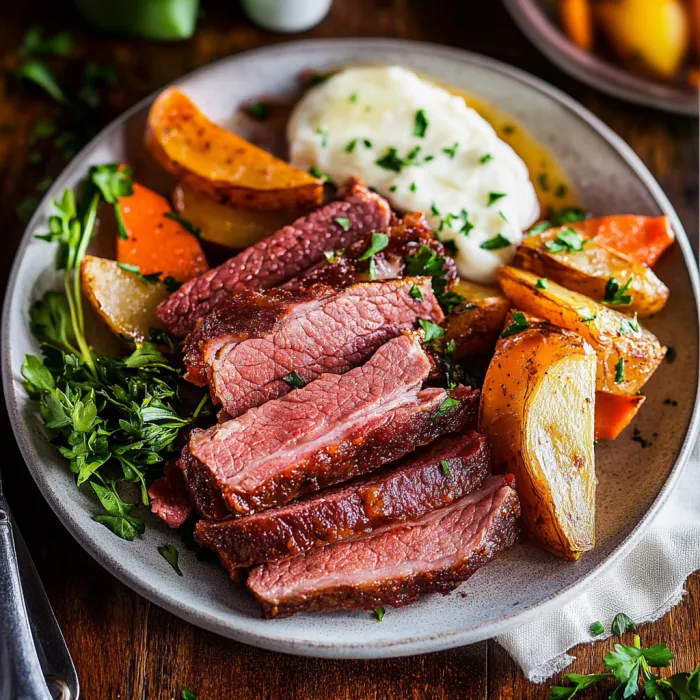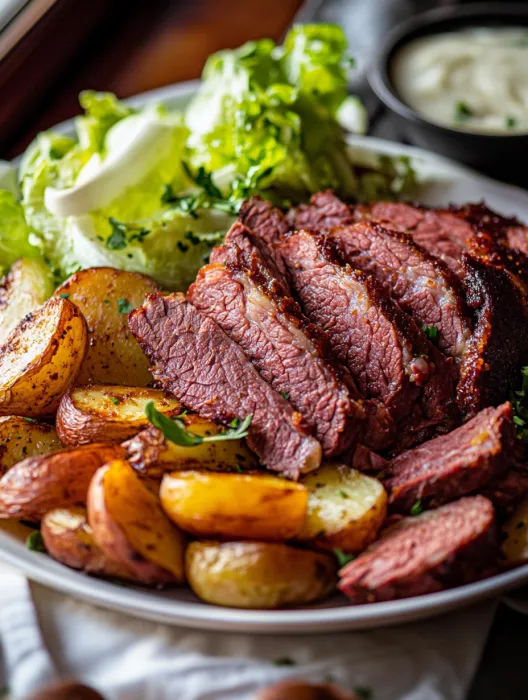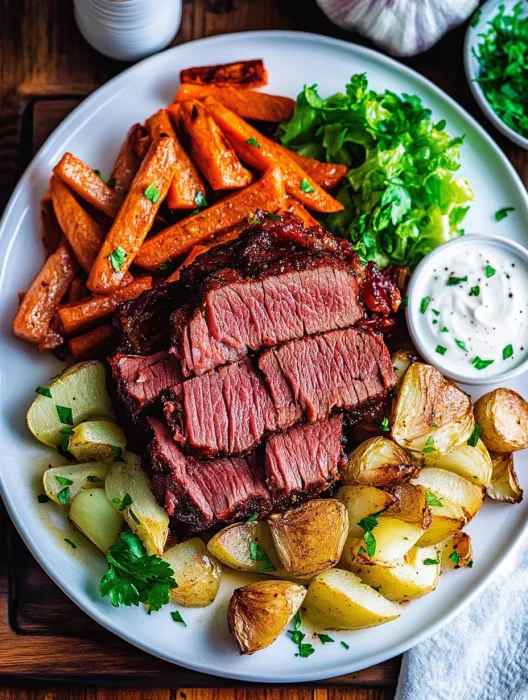 Highlight
Highlight
This corned beef and cabbage recipe has been my family's go-to St. Patrick's Day tradition for years, delivering melt-in-your-mouth meat and perfectly tender vegetables every time. The slow cooker method transforms this humble dish into something truly spectacular.
I discovered this technique after years of disappointing boiled corned beef dinners. The first time I tried this method with the searing step, my Irish-American husband declared it the best he'd ever tasted, and now our friends request it every March.
Ingredients
- Corned beef brisket with spice packet crucial for authentic flavor and the spice packet adds the signature corned beef taste profile
- Oil for searing creates that beautiful crust that seals in juices and enhances flavor
- Beef broth provides richer flavor than water and helps tenderize the meat
- Whole grain mustard adds depth and complexity that complements the beef perfectly
- Garlic and onion build an aromatic foundation for the entire dish
- Fresh thyme and bay leaves infuse the cooking liquid with herbal notes
- Carrots add natural sweetness and hold their shape beautifully during long cooking
- Butter for sautéing cabbage transforms it from bland to caramelized and delicious
- Green cabbage becomes tender while maintaining texture when cooked separately
- Red potatoes roasted separately ensure firm exteriors and fluffy centers unlike mushy slow cooker potatoes
- Horseradish sauce provides the perfect tangy companion to cut through the richness
Step-by-Step Instructions
- Sear the Corned Beef
- Heat a large skillet until very hot before adding oil. Pat the corned beef dry with paper towels after draining the brine. Develop a deep brown crust on both sides for about 2-4 minutes per side. This step creates incredible depth of flavor through caramelization and is absolutely worth the extra time.
- Create the Cooking Liquid
- Combine beef broth with whole grain mustard in the hot skillet you used for searing. The mustard helps tenderize the meat while adding subtle tang. Scrape all those browned bits from the pan as they contain concentrated flavor compounds that will infuse the entire dish.
- Layer the Aromatics
- Add the smashed garlic cloves whole rather than minced to prevent them from burning during the long cook time. Tuck the fresh herbs around the edges where they can perfume the broth without becoming bitter. The onion wedges should be large enough to maintain some structure through cooking.
- Cook the Beef
- Set your slow cooker to low and allow the meat to cook uninterrupted for 6-7 hours. The low temperature breaks down the tough connective tissues without causing the proteins to seize and become tough. Resist the urge to open the lid which releases essential heat and extends cooking time.
- Add the Carrots
- Place carrots on top rather than submerged in liquid to prevent them from becoming waterlogged. The size matters here as they need to hold up during the long cooking process while absorbing the savory broth flavors.
- Prepare the Cabbage
- Sauté the cabbage in butter before adding to the slow cooker. This crucial step develops sweetness and prevents the cabbage from turning mushy or gray. The butter also carries flavor compounds that plain water cannot.
- Roast the Potatoes
- Roast red potatoes separately in a hot oven with olive oil and seasoning. The dry heat creates a delicious contrast to the other components and maintains their structural integrity with crisp exteriors.
- Rest and Serve
- Allow the corned beef to rest before slicing against the grain. This redistributes juices throughout the meat ensuring each bite remains moist and tender. Present components separately on a platter for visual appeal and to let guests choose their portions.

My grandmother always insisted on searing the beef first, a step many recipes skip. She would say "the color in the pot is the flavor on your plate" and she was absolutely right. That simple step elevates this humble dish into something extraordinary that honors our Irish heritage.
Choosing the Right Cut
The flat cut of corned beef brisket is leaner and slices more beautifully for presentation. The point cut contains more marbling and fat which creates incredibly tender results but is sometimes harder to find. Both work wonderfully in this recipe, but if you prefer leaner meat, choose the flat cut. The grain direction matters significantly when slicing corned beef. Look for the lines running through the meat and cut perpendicular to them for the most tender bites.
Leftover Magic
Corned beef actually improves with age, making leftovers something to celebrate. Store the meat and vegetables separately in airtight containers for up to 4 days. For breakfast, chop leftover corned beef and potatoes, crisp them in a cast iron skillet, and top with a fried egg. Alternatively, layer thinly sliced corned beef with Swiss cheese on rye bread with sauerkraut and Russian dressing for classic Reuben sandwiches. Even the cooking liquid can be saved and used as a flavorful base for soups or stews.
The Spice Secret
The spice packet included with most corned beef contains a proprietary blend that gives it that signature flavor. If your corned beef doesn't include one, you can create your own with mustard seeds, coriander seeds, bay leaves, allspice berries, crushed red pepper flakes, and a few cloves. Toast these spices in a dry skillet before adding to intensify their flavors. The aroma will fill your kitchen and signal to everyone that something special is cooking. These warming spices balance the saltiness of the beef perfectly.

Common Questions About the Recipe
- → What's the difference between flat cut and point cut brisket?
Flat cut brisket is leaner, more uniform in shape, and slices beautifully for presentation. Point cut is fattier with more marbling, resulting in juicier, more flavorful meat but less uniform slices. Both work well in this recipe, with the flat cut offering neater serving portions and the point cut providing richer flavor.
- → Why sear the corned beef before slow cooking?
Searing the corned beef before slow cooking creates a delicious caramelized crust through the Maillard reaction, which adds significant depth of flavor to both the meat and the cooking liquid. This step also helps seal in juices, resulting in more tender, flavorful beef.
- → Can I cook the potatoes in the slow cooker with everything else?
While you technically can add potatoes to the slow cooker (adding them with the carrots for 2-3 hours), they'll likely become mushy and gray. For the best texture and flavor, roasting them separately in the oven creates crispy, golden potatoes that provide a perfect textural contrast to the tender meat and vegetables.
- → What's in the spice packet that comes with corned beef?
The spice packet typically contains a blend of broken bay leaves, coriander, peppercorns, mustard seeds, anise, crushed red pepper, dill seeds, and fennel seeds. Some may include small amounts of cloves, allspice, nutmeg, cardamom, or cinnamon. If your corned beef doesn't include a packet, you can create your own blend using these spices.
- → How do I know when my corned beef is perfectly cooked?
Perfectly cooked corned beef should reach approximately 200°F on a meat thermometer and feel fork-tender—a fork should easily slide in with minimal resistance. The meat should be soft enough to pull apart easily but still hold together when sliced against the grain. For oven preparation, this temperature is the ideal indicator of doneness.
- → Why do you sauté the cabbage separately instead of adding it raw?
Sautéing the cabbage in butter before adding it to the slow cooker serves two important purposes: it jumpstarts the cooking process, allowing the cabbage to better absorb the flavorful broth in the shorter final cooking time, and it adds a rich buttery flavor that complements the savory beef. This method prevents overcooking while ensuring the cabbage is perfectly seasoned.
